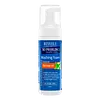What's inside
What's inside
 Key Ingredients
Key Ingredients

No key ingredients
 Benefits
Benefits

 Concerns
Concerns

 Ingredients Side-by-side
Ingredients Side-by-side

Water
Skin ConditioningSodium Lauroyl Sarcosinate
CleansingCocamidopropyl Betaine
CleansingGlycerin
HumectantDisodium Cocoyl Glutamate
CleansingSodium Cocoyl Glutamate
CleansingCoco-Glucoside
CleansingGlyceryl Oleate
EmollientPhenoxyethanol
PreservativeSalicylic Acid
MaskingPEG-40 Hydrogenated Castor Oil
EmulsifyingAcrylates/Palmeth-25 Acrylate Copolymer
Parfum
MaskingMelaleuca Alternifolia Leaf Oil
AntioxidantCI 61585
Cosmetic ColorantCI 42090
Cosmetic ColorantHexyl Cinnamal
PerfumingWater, Sodium Lauroyl Sarcosinate, Cocamidopropyl Betaine, Glycerin, Disodium Cocoyl Glutamate, Sodium Cocoyl Glutamate, Coco-Glucoside, Glyceryl Oleate, Phenoxyethanol, Salicylic Acid, PEG-40 Hydrogenated Castor Oil, Acrylates/Palmeth-25 Acrylate Copolymer, Parfum, Melaleuca Alternifolia Leaf Oil, CI 61585, CI 42090, Hexyl Cinnamal
Water
Skin ConditioningSodium Cocoamphoacetate
CleansingSodium Lauroyl Sarcosinate
CleansingGlycerin
HumectantLauryl Glucoside
CleansingGlycol Distearate
EmollientSodium Cocoyl Glutamate
CleansingSodium Lauryl Glucose Carboxylate
CleansingAlthaea Officinalis Root Extract
Skin ConditioningEthylhexylglycerin
Skin ConditioningHexylene Glycol
EmulsifyingLavandula Angustifolia Flower Extract
CleansingLinalool
PerfumingLimonene
PerfumingPhenoxyethanol
PreservativePhoenix Dactylifera Fruit Extract
EmollientPEG-150 Distearate
EmulsifyingSalix Alba Bark Extract
AstringentWater, Sodium Cocoamphoacetate, Sodium Lauroyl Sarcosinate, Glycerin, Lauryl Glucoside, Glycol Distearate, Sodium Cocoyl Glutamate, Sodium Lauryl Glucose Carboxylate, Althaea Officinalis Root Extract, Ethylhexylglycerin, Hexylene Glycol, Lavandula Angustifolia Flower Extract, Linalool, Limonene, Phenoxyethanol, Phoenix Dactylifera Fruit Extract, PEG-150 Distearate, Salix Alba Bark Extract
Ingredients Explained
These ingredients are found in both products.
Ingredients higher up in an ingredient list are typically present in a larger amount.
Glycerin is already naturally found in your skin. It helps moisturize and protect your skin.
A study from 2016 found glycerin to be more effective as a humectant than AHAs and hyaluronic acid.
As a humectant, it helps the skin stay hydrated by pulling moisture to your skin. The low molecular weight of glycerin allows it to pull moisture into the deeper layers of your skin.
Hydrated skin improves your skin barrier; Your skin barrier helps protect against irritants and bacteria.
Glycerin has also been found to have antimicrobial and antiviral properties. Due to these properties, glycerin is often used in wound and burn treatments.
In cosmetics, glycerin is usually derived from plants such as soybean or palm. However, it can also be sourced from animals, such as tallow or animal fat.
This ingredient is organic, colorless, odorless, and non-toxic.
Glycerin is the name for this ingredient in American English. British English uses Glycerol/Glycerine.
Learn more about GlycerinPhenoxyethanol is a preservative that has germicide, antimicrobial, and aromatic properties. Studies show that phenoxyethanol can prevent microbial growth. By itself, it has a scent that is similar to that of a rose.
It's often used in formulations along with Caprylyl Glycol to preserve the shelf life of products.
Sodium Cocoyl Glutamate is a gentle cleanser and surfactant. It is the sodium salt of the Cocoyl Glutamic Acid and comes from coconut oil. As a surfactant, it helps lift dirt and oil to be washed away.
Sodium Cocoyl Glutamate also has an emolliating effect and can help leave the skin feeling soft.
Sodium Lauroyl Sarcosinate is a cleansing agent and emulsifier. It is a surfactant derived from sarcosine, and a common source is coconut oil.
As a surfactant, Sodium Lauroyl Sarcosinate helps lift dirts, oil, and other molecules to be washed away. In leave-on products, this ingredient is used as an emulsifier. Emulsifier help prevent ingredients such as oils and waters from separating.
Sodium Lauroyl Sarcosinate is also commonly found as a foaming agent in shampoo, toothpaste, and shaving foam. It is amphiphilic, meaning it loves both water and fats.
Learn more about Sodium Lauroyl SarcosinateWater. It's the most common cosmetic ingredient of all. You'll usually see it at the top of ingredient lists, meaning that it makes up the largest part of the product.
So why is it so popular? Water most often acts as a solvent - this means that it helps dissolve other ingredients into the formulation.
You'll also recognize water as that liquid we all need to stay alive. If you see this, drink a glass of water. Stay hydrated!
Learn more about Water